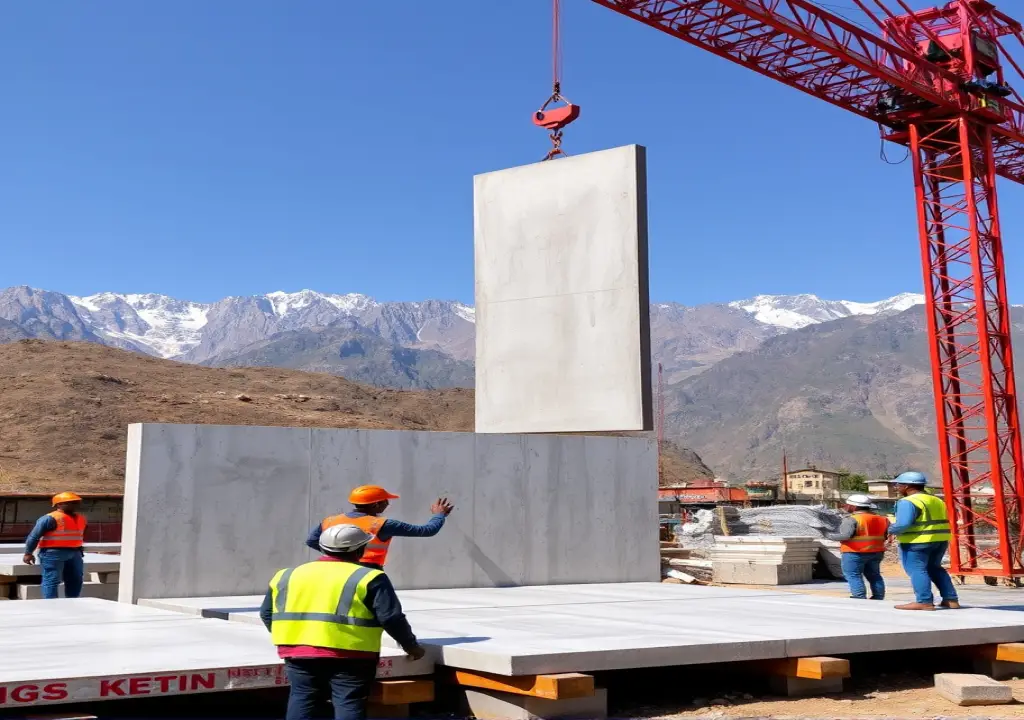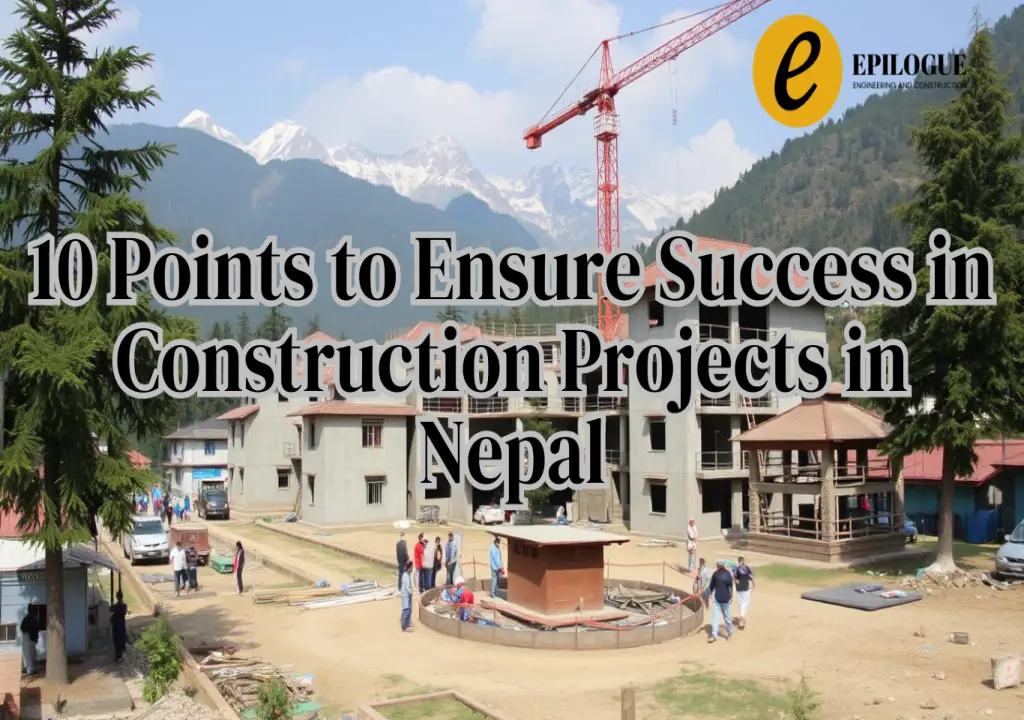Search Blogs

Precast Concrete: The Future of Efficient Construction in Nepal
Precast concrete is becoming a game-changer in the construction industry, not just globally but also in Nepal. Unlike traditional concrete, which is poured and cured on-site, precast concrete is manufactured in a controlled environment, often in a factory, and then transported to the construction site for installation. This modern method offers several advantages in terms of efficiency, cost, and durability, making it an ideal solution for Nepal’s evolving construction landscape. Why Precast Concrete is Ideal for Nepal: Faster Construction Time: One of the key benefits of using precast concrete is the reduction in construction time. Since the concrete elements are pre-made in a factory, the on-site work is streamlined. This is especially useful in Nepal, where seasonal challenges like monsoon rains can cause delays in traditional construction methods. Durability and Strength: Precast concrete elements are known for their strength and durability. In a country like Nepal, which is prone to earthquakes, the structural integrity provided by precast concrete offers enhanced resistance to seismic activities. It also stands up well against extreme weather conditions, making it suitable for the varied climate zones of Nepal. Cost-Effective and Efficient: Precast concrete can lead to significant cost savings in the long run. While the initial investment might seem higher than traditional construction methods, the faster completion time reduces labor costs and limits on-site material wastage. Additionally, because it is produced in a controlled environment, quality control is maintained, minimising defects. Eco-Friendly Construction: In today’s environmentally conscious world, precast concrete is considered a more sustainable option. The controlled manufacturing process reduces waste, and the material can often be recycled. With the rise of green building initiatives in Nepal, precast concrete can contribute to achieving eco-friendly certifications for projects. Versatility in Design: Precast concrete is highly versatile and can be customised to suit a wide range of building types, from residential homes to large commercial complexes. It can be used for walls, beams, floors, and even decorative facades, allowing architects and engineers in Nepal to explore various design possibilities. Applications of Precast Concrete in Nepal: Residential Buildings: From houses to apartment complexes, precast concrete can speed up construction and provide strong, durable structures. Commercial and Industrial Projects: Office buildings, factories, and warehouses benefit from the efficiency and cost savings that precast concrete offers. Infrastructure Projects: Bridges, tunnels, and retaining walls are commonly built using precast concrete due to their durability and ability to handle heavy loads.
Published By: ADMIN
Published On: Sep 23, 2024, 10:49:56 AM * 5 min to complete.

Key Aspects of Vastu Shastra
Vastu Shastra is an ancient Indian architectural science that provides guidelines for designing and constructing buildings in harmony with natural forces. It emphasizes the arrangement, design, and orientation of spaces to create a balanced and positive living environment. Below is a comprehensive overview of the need for Vastu Shastra in-house construction and the benefits of following its principles: 1. Site Selection and Orientation - Site Selection: Vastu Shastra emphasizes selecting a site with good soil quality, proper drainage, and a balanced landscape. The land should be regular in shape, ideally square or rectangular, with a level surface. - Orientation: The orientation of the house is crucial in Vastu. The main entrance should ideally face north, east, or northeast, as these directions are associated with positive energy and prosperity. South-facing homes can be challenging but can be managed with specific Vastu remedies. 2. Room Placement and Function - Living Room: The living room should be in the north, northeast, or east to allow maximum natural light and positive energy flow. - Kitchen: The kitchen should be located in the southeast corner, governed by the fire element, which is considered ideal for cooking. The northeast corner should be avoided for kitchens. - Bedroom: The master bedroom is best placed in the southwest direction, promoting stability and health. Children’s bedrooms can be in the west or northwest. - Bathroom and Toilets: These should be in the northwest or southeast direction, with proper ventilation to avoid negative energy accumulation. - Pooja Room: The prayer room should be in the northeast corner, which is considered the most sacred and auspicious direction. 3. Energy Flow and Balance - Windows and Doors: Windows should be placed on the north and east walls to allow the flow of positive energy. The number of doors and windows should be even to balance energy circulation within the house. - Central Space (Brahmasthan): The center of the house, known as Brahmasthan, should be kept open or with minimal construction to allow the free flow of energy. Heavy furniture or structures in this area can block energy flow. - Staircase Placement: The staircase should be in the southwest, south, or west direction. Staircases in the northeast can lead to financial instability. 4. Materials and Colors - Materials: Natural materials like wood, stone, and clay are preferred in Vastu Shastra, as they are believed to align better with natural energy forces. - Colors: Vastu Shastra recommends using colors that correspond to the direction and element. For example, blue or green in the east (air element), red in the southeast (fire element), and white or cream in the northwest (air element). 5. Additional Considerations - Water Bodies: Water bodies like wells, fountains, or swimming pools should be placed in the northeast direction to enhance positive energy and prosperity. - Septic Tank Placement: The septic tank should be placed in the northwest direction to avoid negative effects on health and wealth. - Lighting and Ventilation: Adequate natural lighting and ventilation are crucial to maintain the balance of energy in the house. Rooms should be well-ventilated, and artificial lighting should complement natural light. Benefits of Constructing a House According to Vastu Shastra 1. Enhanced Well-Being and Health - Vastu Shastra promotes the construction of homes that allow natural light and air to circulate freely, which can improve the overall health and well-being of the occupants. Proper room placement and orientation ensure that each member of the household receives the maximum benefit from positive energy sources. 2. Financial Prosperity - Following Vastu principles can lead to financial stability and prosperity. Correct placement of the entrance, rooms, and kitchen can attract wealth and reduce financial obstacles. For instance, placing the kitchen in the southeast direction, governed by the fire element, is believed to enhance financial success. 3. Harmonious Relationships - Vastu Shastra emphasizes creating spaces that foster harmony and peace among family members. The correct placement of bedrooms, living areas, and the pooja room helps maintain positive interactions and reduces conflict. The southwest placement of the master bedroom, for example, strengthens the relationship between partners. 4. Positive Energy Flow - The design and layout of the house according to Vastu ensure that positive energy flows throughout the home, creating an environment of peace, positivity, and mental clarity. This balanced energy flow can enhance creativity, reduce stress, and promote mental well-being. 5. Spiritual Growth and Peace - Constructing a house with Vastu Shastra principles supports spiritual well-being by aligning the living space with cosmic energy. The northeast direction, considered the most auspicious, is ideal for meditation and spiritual activities, promoting a sense of peace and connection with the divine. 6. Protection from Negative Influences - Vastu Shastra provides guidelines to avoid or mitigate the impact of negative energies. For example, proper placement of septic tanks and avoiding the construction of toilets in certain areas can protect the home from health issues and negative influences. 7. Long-Term Happiness and Success - A home built according to Vastu Shastra is believed to bring long-term happiness, success, and fulfillment to its inhabitants. The harmonious environment created by Vastu principles can lead to personal and professional growth, making the home a true haven for its residents. In summary, Vastu Shastra offers a holistic approach to house construction, ensuring that the living space is in harmony with natural forces. By following Vastu guidelines, homeowners can create a balanced, positive, and prosperous environment that enhances well-being, success, and happiness.
Published By: Admin
Published On: Sep 04, 2024, 10:08:13 AM * 5

How to Ensure Success in Construction Projects in Nepal?
Undertaking construction projects in Nepal, especially in dynamic urban centers like Kathmandu, requires a meticulous approach and careful planning. From understanding local regulations to managing budgets and engaging with the community, every detail matters. Here are the nine most important steps to help ensure the success of any construction project in Nepal. 1. The Importance of Proper Planning Proper planning forms the foundation of any successful construction project. It involves setting clear objectives, defining project scopes, and outlining timelines. In Nepal, where the terrain and climate can be challenging, planning helps identify potential obstacles early on. Effective planning includes risk assessment, resource allocation, and the establishment of milestones. This approach ensures that all phases of the project are aligned, reducing delays and unforeseen costs. 2. Understand Local Regulations and Permits Compliance with local regulations and obtaining the necessary permits are crucial steps in the construction process. Each municipality in Nepal, including Kathmandu, has its own set of rules that govern construction activities. Navigating these regulations can be complex, but it is essential to avoid legal issues or delays. Work closely with local authorities to ensure all documentation is in order, from zoning laws to environmental clearances, to keep your construction projects on track. 3. Site Selection and Preparation Choosing the right site is critical for any construction project. In Nepal, site selection should consider factors such as land stability, accessibility, and proximity to essential utilities. Once the site is selected, proper preparation must be carried out to make it ready for construction. This includes soil testing, land clearing, and leveling. A well-prepared site minimizes risks during construction and lays a solid foundation for future structures. 4. Prioritize Earthquake-Resistant Design Nepal is located in a seismically active region, making earthquake-resistant design a top priority for any construction company. Use materials and construction techniques that enhance the building’s ability to withstand seismic activity. Incorporate structural reinforcements, flexible building materials, and advanced engineering methods. Ensuring earthquake resilience not only protects lives but also preserves the investment over the long term. 5. Premium Materials and Professional Labor In Nepal, a successful construction project requires high-quality materials and skilled labor. Environmental factors like monsoons, temperature fluctuations, and seismic activity necessitate the use of quality materials. Skilled labor ensures efficient, safe, and high-standard completion of construction projects, despite the unique challenges faced by Nepal. 6. Budgeting and Cost Estimation Accurate budgeting and cost estimation are vital for managing construction projects effectively. Develop a detailed budget that covers all aspects, from materials and labor to permits and contingency funds. Regularly review and adjust the budget to reflect actual expenses and changes in project scope. This level of financial oversight helps prevent cost overruns and keeps the project within the planned financial framework. 7. Ensure Quality Control Quality control is essential to maintain high standards throughout the construction process. Regular inspections, material testing, and adherence to building codes are necessary to ensure that every phase meets the required quality standards. By implementing a robust quality control process, you can identify and rectify potential issues early, reducing the risk of costly rework and ensuring the longevity of the construction. 8. Effective Project Management Effective project management is the backbone of successful construction projects in Nepal. This includes coordinating with various stakeholders, managing resources, and ensuring that the project stays on schedule and within budget. Use project management tools and techniques to track progress, handle delays, and allocate resources efficiently. Strong project management minimizes risks and maximizes productivity, ensuring a smooth construction process. 9. Embrace Sustainable Practices In today’s world, embracing sustainable practices is no longer optional—it’s a necessity. Opt for eco-friendly materials, energy-efficient designs, and waste-reduction strategies to minimize the environmental impact of your construction projects. In Nepal, where natural resources are precious, sustainable construction practices can also lead to cost savings and improved community relations. 10. Communication is Key Clear and consistent communication is crucial in any construction project. Keep all stakeholders, from clients to contractors, informed about project progress, changes, and potential challenges. Regular updates and transparent communication help build trust, foster collaboration, and ensure that everyone is aligned with the project’s goals. Conclusion By focusing on these nine critical aspects, you can ensure the success of your construction projects in Nepal. Proper planning, understanding local regulations, selecting the right site, and prioritizing quality and sustainability are essential. Combine these with effective project management and open communication to deliver outstanding results in the competitive construction landscape of Kathmandu and beyond.
Published By: Epilogue Engineering and Construction
Published On: Aug 29, 2024, 10:50:31 AM * 5 min to complete.